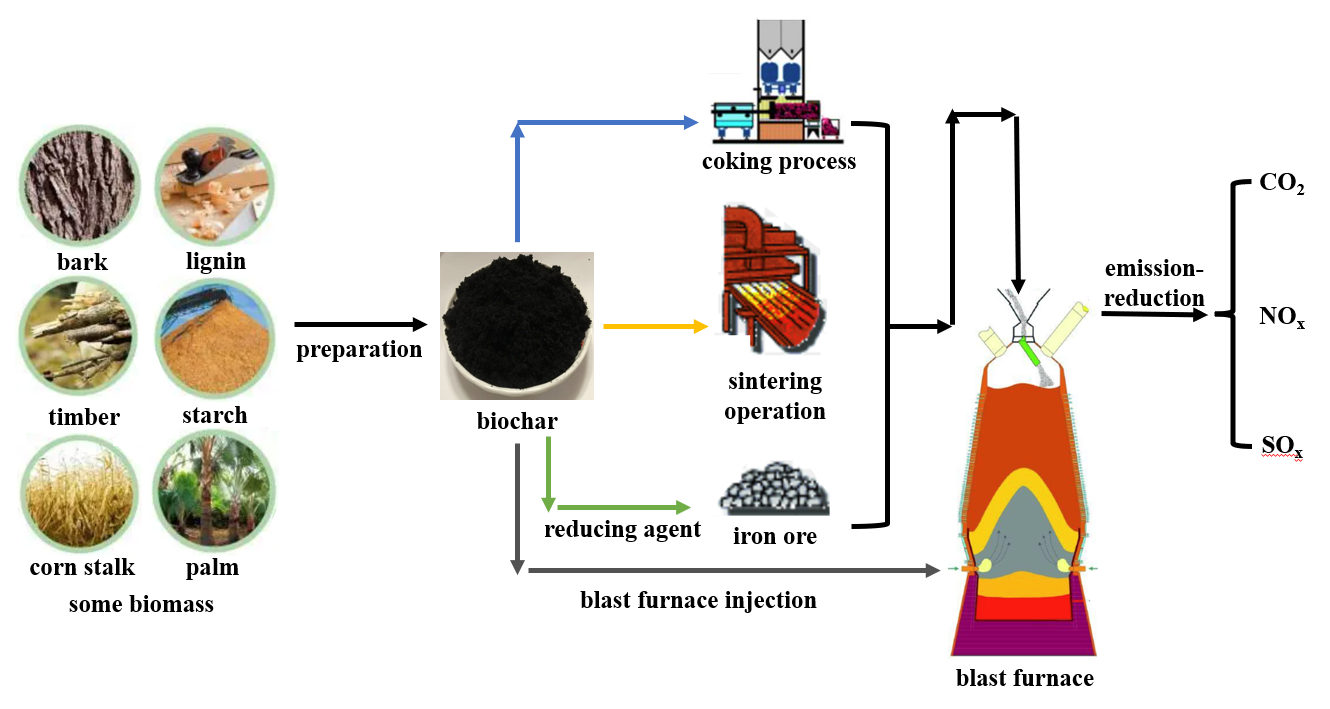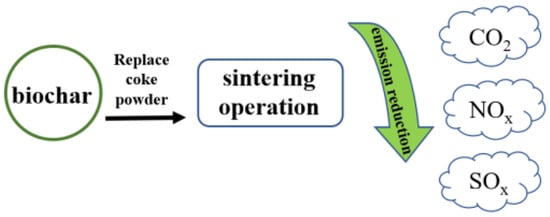
| Version | Summary | Created by | Modification | Content Size | Created at | Operation |
|---|---|---|---|---|---|---|
| 1 | Shijie Wang | -- | 2131 | 2023-11-09 09:32:13 | | | |
| 2 | Lindsay Dong | Meta information modification | 2131 | 2023-11-12 13:42:30 | | |
Video Upload Options
The concept of green, low-carbon and clean energy consumption has been deeply rooted in the hearts of the people, and countries have actively advocated the use of new energy. In the face of problems such as resource shortage and environmental pollution, scholars began to explore the use of new fuels instead of coal for production. Biomass resources have the characteristics of being renewable and carbon neutral and having large output. As an energy utilization, it is helpful to promote the transformation of the energy structure in various countries. Applying it to ironmaking production is not only conducive to energy conservation and emission reduction in the ironmaking process but also can achieve efficient utilization of crop waste.
1. Introduction
2. Preparation of Biochar
3. Application of Biochar in the Ironmaking Process

3.1. Application of Biochar in Coking Process
3.2. Application of Biochar in Sintering Operation

3.3. Application of Biochar in Iron Ore Reduction

3.4. Biochar Used in Blast Furnace Injection
References
- Wang, G.; Zhang, H.Q. Carbon emission status and carbon reduction prospect of iron and steel industry in China. Chem. Miner. Process. 2021, 50, 55–64.
- In 2021 China’s raw coal production will reach 4.13 billion tons. China Coal News, 1 March 2022.
- He, K.; Wang, L. Development and current situation of energy consumption in iron and steel industry in China. China Metall. 2021, 31, 26–35.
- Birat, J.P. Society, Materials, and the Environment: The Case of Steel. Metals 2020, 10, 331.
- Mousa, E.; Wang, C.; Riesbeck, J.; Larsson, M. Biomass applications in iron and steel industry: An overview of challenges and opportunities. Renew. Sustain. Energy Rev. 2016, 65, 1247–1266.
- Liu, W.Q. Research on low carbon ironmaking technology. China Environ. Prot. Ind. 2011, 01, 20–25.
- Wang, D.W. Development status and future prospects of ‘hydrogen metallurgy’. Metall. Manag. 2021, 14, 47–49.
- Wei, R.F.; Zhu, Y.L.; Long, H.M.; Xu, C.B. Research status and prospect of biomass iron ore pellets. Sintered Pellet. 2022, 47, 29–37.
- Machado, J.G.M.S.; Oso’rio, E.; Vilela, A.C.F.; Babich, A.; Senk, D.; Gudenau, H.W. Reactivity and conversion behaviour of brazilian and imported coals, charcoal and blends in view of their injection into blast furnaces. Steel Res. Int. 2010, 81, 9–16.
- Nwachukwu, C.M.; Olofsson, E.; Lundmark, R.; Wetterlund, E. Evaluating fuel switching options in the Swedish iron and steel industry under increased competition for forest biomass. Appl. Energy 2022, 324, 119878.
- Mandova, H.; Leduc, S.; Wang, C.; Wetterlund, E.; Patrizio, P.; Gale, W.; Kraxner, F. Possibilities for CO2 emission reduction using biomass in European integrated steel plants. Biomass Bioenergy 2018, 115, 231–243.
- Ladanai, S.; Vinterbäck, J. Global Potential of Sustainable Biomass for Energy; Department of Energy and Technology, Swedish University of Agriculture Sciences: Uppsala, Sweden, 2009; pp. 1654–9406.
- Hammerschmid, M.; Müller, S.; Fuchs, J.; Hofbauer, H. Evaluation of biomass-based production of below zero emission reducing gas for the iron and steel industry. Biomass Convers. Biorefinery 2021, 11, 169–187.
- Zhou, M.C.; Liu, W. Carbon emission reduction and biomass resource utilization. Chem. Des. 2022, 32, 11–14.
- Wang, X.D.; Shang, G.Q.; Xing, Y.; Hou, C.J.; Tian, J.L. Research on the low-carbon development technology route of iron and steel enterprises under the ‘double carbon. Chin. J. Eng. 2023, 45, 853–862.
- Zhang, Q.; Zhang, W.; Wang, Y.L. Energy saving and emission reduction potential of China’s iron and steel industry and ways to improve energy efficiency. Steel 2019, 54, 7–14.
- Peng, W.M.; Wu, Q.Y. Biomass Pyrolysis Fuel Production. New Energy 2000, 22, 39–44.
- Wei, R.F.; Zhang, L.L.; Cang, D.Q.; Li, J.X.; Li, X.W.; Xu, C.C. Current status and potential of biomass utilization in ferrous metallurgical industry. Renew. Sustain. Energy Rev. 2017, 68, 511–524.
- Seo, M.W.; Jeong, H.M.; Lee, W.J.; Yoon, S.J.; Ra, H.W.; Kim, Y.K.; Lee, D.; Han, S.W.; Kim, S.D. Carbonization characteristics of biomass/coking coal blends for the application of bio-coke. Chem. Eng. J. 2020, 394, 124943.
- Yuuki, M.; Naoto, T. Preparation of coke from biomass char modified by vapour deposition of tar generated during pyrolysis of woody biomass. Ironmak. Steelmak. 2022, 49, 646–657.
- Gan, M.; Li, H.R.; Fan, X.H. Combustion characteristics of core biochar and its emission reduction behavior in sintering. Sintered Pellets 2022, 47, 65.
- Huang, Z.C.; Jin, Y.Y.; Yi, L.Y. Pyrolysis characteristics of biomass and its reduction of iron concentrate. Sintered Pellets 2021, 46, 65–71.
- Chen, W.H.; Wu, J.S. An evaluation on rice husks and pulverized coal blends using a drop tube furnace and a thermogravimetric analyzer for application to a blast furnace. Energy 2009, 34, 1458–1466.
- Li, J.H.; Xu, R.S.; Wang, G.W.; Zhang, J.L.; Song, B.; Liang, W.; Wang, C. Study on the feasibility and co-combustion mechanism of mixed injection of biomass hydrochar and anthracite in blast furnace. Fuel 2021, 304, 121465.
- Zheng, W.C.; Xu, C.B.; Wei, R.F. Research progress of biochar injection into blast furnace. J. Iron Steel Res. 2021, 33, 1–8.




